MXA INTERVIEW: MITCH PAYTON IS THE GREATEST TUNER OF ALL TIME
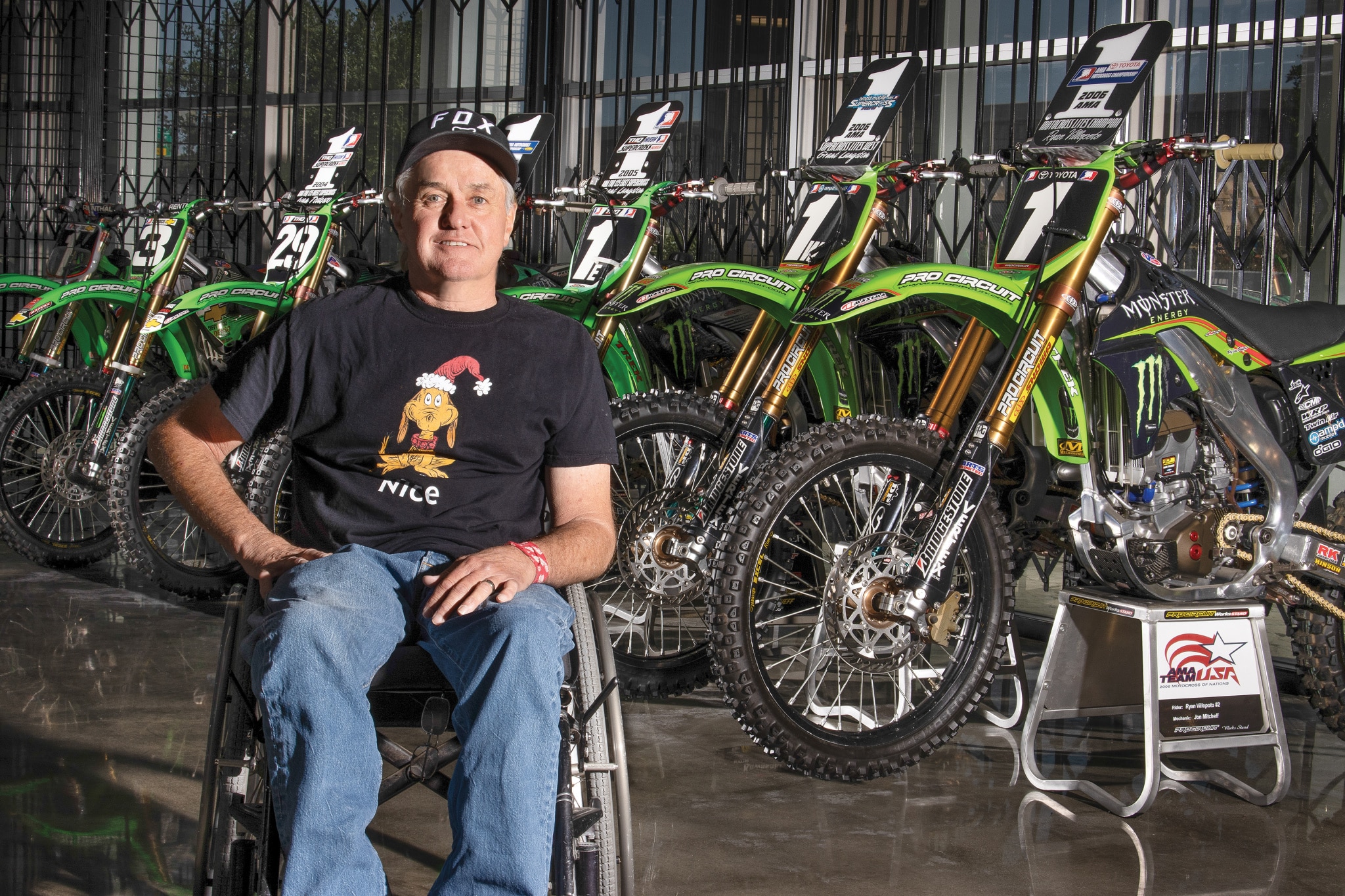
BY JIM KIMBALL
MITCH, WHAT WAS YOUR FIRST EXPOSURE TO DIRT BIKES? Some friends of my dad bought a Honda ATC90, and we thought that was so cool! We had always talked to our parents about getting a go-kart, but where we lived was mostly dirt. My parents bought us a minibike. My brother and I were at my grandmother’s house. My mom called and said, “We got you something.”
We were like, “What is it? What is it?” Back then, you got on the phone with a long cord. My mom held the phone outside the house, and my dad started the bike.
I asked, “We got a new lawnmower?”
She said, “No, it is a motorcycle.”
We said, “No way! You better come pick us up.” It was a Honda CT90 step-through. We did lap after lap, and we fell in love with it.

WAS YOUR WHOLE FAMILY RIDING? Yes, we would go to the desert every weekend and ride around. Back then, they had family enduros. My brother, who was three years older and faster, rode with my dad. I rode with my mom, who was a great rider. She was the first one in the family to get a motorcycle trophy.
DID THAT PROMPT YOU TO RACE MORE? Yes, racing was fun, but I was slow. There were not all these different classes back then. I had a minibike with a 100cc engine in it, so I rode the 100 class. If you were slow, you were a novice. If you got faster, you were an amateur, and if you were fast, you were an expert. At age 11, I was a novice. I raced against guys that may have been my age or as much as 40 years old. It was just engine displacement classes; no age groups.
HOW DID YOU PROGRESS? I rode the 100 class, which in the early 1970s was very competitive and very popular. That was the cool class for us young guys, because it was the smallest bike. 100cc racing was very big in the heyday of desert racing. Mitch Mayes, Larry Roeseler, Bruce Ogilvie and, before them, Terry Clark were all famous guys in that class. The Brooks brothers and Jack Morgan raced 100s, too. I raced a Hodaka when they were getting towards the end of their life.
I got to where I was winning amateur races, then I could lead the Expert class for a while before getting tired. But still, I was leading the Expert class! At age 14, I was beating guys that were in their early 20s. Finally, it got to where the Hodaka broke down constantly. I told my parents, “I want to quit. I’m not having fun anymore.” It was fun to be sponsored, but not fun to always be breaking down.
BUT YOU DIDN’T QUIT, DID YOU? No. My parents bought me a Husky 125 from Anaheim Sport Cycle. The owner’s name was Don Lewis. My brother, dad and mom all had Huskies. I started racing it. Things happened fast, and I got better and better.
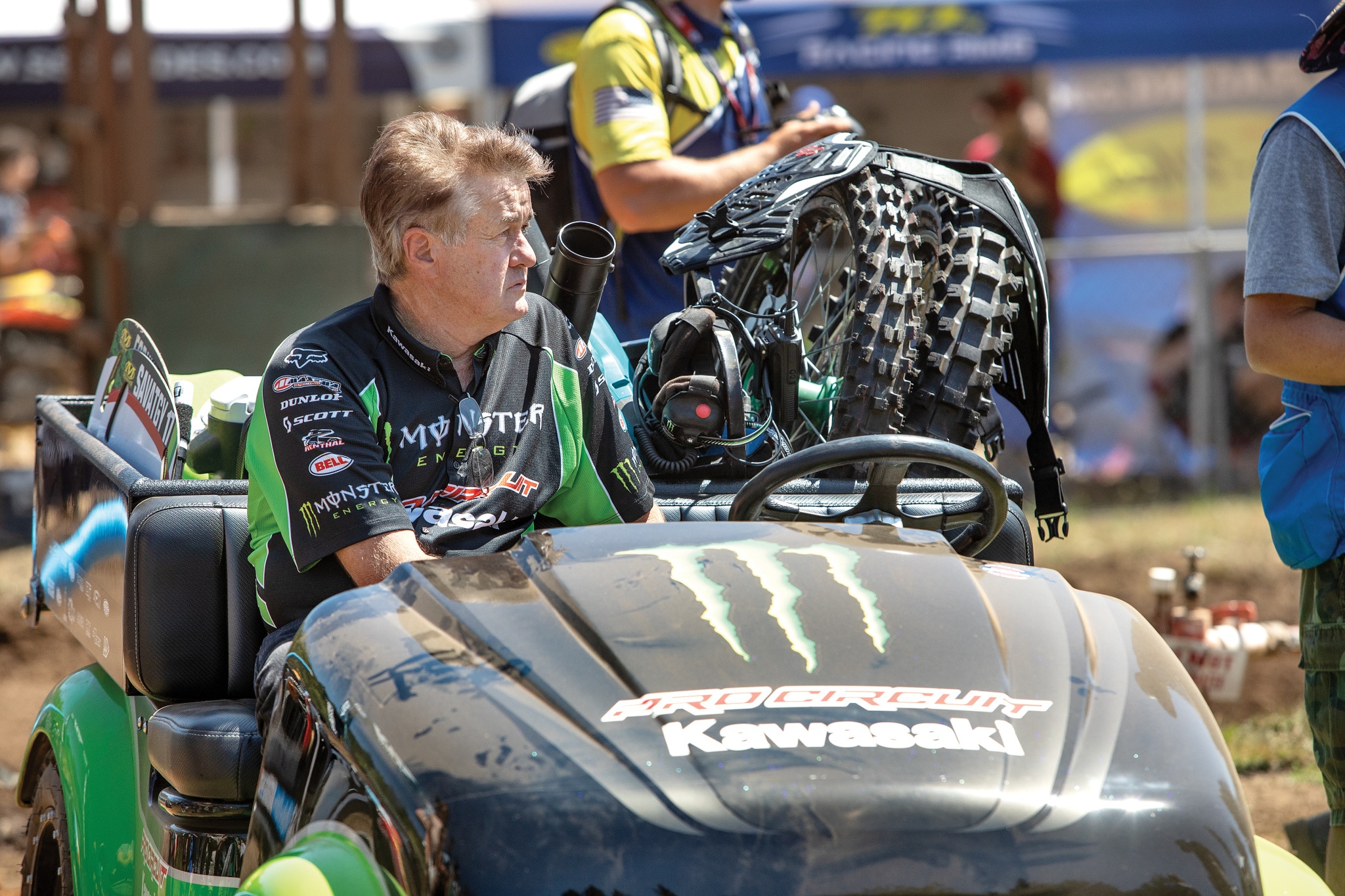 Mitch and his band of buddies are big practical jokers, but at the races he is very serious.
Mitch and his band of buddies are big practical jokers, but at the races he is very serious.
YOU EVENTUALLY BECAME DISTRICT 37’S 125 DESERT CHAMPION. I got the Husky just before I turned expert. I began winning occasionally, and then it became frequent. The year I got the number-one plate, I was winning a lot. I wasn’t racing all the time because I was only 16 and still in high school, but I had big dreams of being like A.C. Bakken, Larry Roeseler, Mitch Mayes—all those guys. I wanted to ride the Score Off-Road World Championship races, too.
DID YOU? The Parker 400 was coming up, and I asked my parents if I could race it. They said, “The entry fee is 400 bucks, and we don’t have that.”
Another guy in our club, Mick Thorp, said, “There is a motorcycle swap meet next week. We will clean out your garage, take anything we can sell and see if we can raise the money.” I came home with $430.
My parents said, “I guess you can do it.” I was stoked and was lucky that I was going to team up with a rider I still see all the time, Jeff Kaplan.
Jeff was the number-one 125 guy the year before me. He moved up to the 250 class and wanted to race the off-road races. Riding with Jeff was awesome. We won the Parker 400 just before Jeff broke his wrist while getting ready for the Vegas 400. So, I rode the Vegas 400 with Andy Kirker. The bike broke on the first lap, so we did not win that one. Then we won the Baja 500 and were getting ready for the Baja 1000. Then I got hurt in September. I never got to ride the Baja 1000, and I wish I would have been able to ride that one, because as a kid you read all the race articles or watch “On Any Sunday.” Malcolm Smith was seen as a hero for winning the Baja 1000 if you were a kid in the 1970s.
“YES, I DO. I ALWAYS WANTED TO WIN AN OVERALL ON MY 125, AND THAT IS HARD TO DO AGAINST THE BIG BIKES IF YOU DON’T GET A GOOD START. ”
DO YOU STILL REMEMBER THE DAY YOU GOT HURT? Yes, I do. I always wanted to win an overall on my 125, and that is hard to do against the big bikes if you don’t get a good start. But, because this race was a timed start, it was possible. When I got to the first check, I was eighth overall and had passed a lot of guys in front of me. Earlier, at the riders’ meeting, they said, “There is a bad downhill, and you are going to have to walk down it.”
I was hanging out with Larry Roeseler and asked him, “Do you think that is true?”
He said, “I don’t think so. I am not walking down it.”
I replied, “Me neither.”
When I got to the hill, it was very steep. I couldn’t even see the bottom from the top.
WHAT DID YOU DO? I started to ride down it, but I killed the engine and slid down. Then I fell over. I remember getting up, being on the bike with the engine dead and skidding down like everything was cool, but I clipped a rock with the rear wheel. Because it was so steep, I thought I was going to go end over end, but instead I fell into a ravine with rocks at the bottom. It knocked me out, and my elbow was bleeding. I remember waking up, and my brother was there with a few friends.
 A 20-year-old Mitch Payton in his shop in Anaheim.
A 20-year-old Mitch Payton in his shop in Anaheim.
DID YOU REALIZE YOU WERE BADLY HURT? It was strange because I was lying flat, and when I looked down, I could not see my knees. Every time I had knocked the wind out of myself, I tucked my legs up, so it felt like my knees should have been up. I thought, “Something is weird.”
They pulled a boot off and said, “Wiggle your toes.” I was convinced that they wiggled, but they did not wiggle. I knew that was very bad news. I had seen this previously when Mitch Mayes was paralyzed.
I remember seeing him and saying, “You will be okay.”
He replied, “I don’t know. We will see.”
After Mitch Mayes’ injury, my dad said, “We should get out of this. That was terrible.”
I replied, “Oh, come on. That’s one in a million.” I really thought it was. Mitch Mayes was insanely fast in the desert and was a great motocross racer. He won Baja many times and was way better than I was. To see him hurt shook me up, but I thought, “There is no way that’s me.”
THAT HAD TO BE A DIFFICULT TIME. I tried to find something in motorcycles that I could do in a wheelchair. The little Husky shop I rode for, Anaheim Sport Cycle, had already been sold to another guy who was not making money. All my friends were racing, and I quickly realized that they were not going to stay home and visit me on the weekends. If I wanted to see them, I had to go to the races. I had some money saved up, and my parents took a second mortgage on their house. That is how I got Anaheim Husqvarna. I was 18 years old.

This was the loyal Pro Circuit gang that hung out at Anaheim Husqvarna after Mitch bought it. (From Left to right) Bill Keefe, Lance Sallis, Steve Wiseman, Jody Weisel, Mitch Payton, Mike Monaghan and Steve Ballmer.
“YES, BUT I LOVED THE HUSQVARNA BRAND. IMMEDIATELY, I STARTED WORKING ON TRYING TO MAKE THE BIKE FASTER.
YOU BOUGHT A HUSQVARNA DEALERSHIP JUST AS THE JAPANESE BRANDS WERE TAKING OVER. Yes, but I loved the Husqvarna brand. Immediately, I started working on trying to make the bikes faster. Ed Zarp rode desert for me, but I wanted to do motocross. Goat Breker was riding motocross for Husky at the time, but the bikes were too slow. So, we had to figure out how to make them faster. That was my big challenge.
MXA test rider Lance Moorewood brought Jeff Jennings, who was out of a ride, to my shop, and I said, “Do you want to ride a Husky?”
He said, “I don’t know. I’ve never ridden one.” He had been a factory Suzuki rider when Hannah was good. Jeff rode for me for a couple of years. We had a lot of local wins with him and sold a lot of Husky parts.
YOU HELPED KEEP HUSQVARNA RELEVANT IN THOSE DAYS. We did, although I don’t know if they thought about it that way. I wanted Husqvarna to do more, and I remember Mark Blackwell telling me, “This motocross thing, I don’t know if it is going to work for you.” I was 19 years old, and here I was talking to Mark Blackwell, a super-respected 500 National champ and the president of Husqvarna.
I said, “Just give me the budget, and I will race. I can make the bikes faster than you guys can.”
He said, “Concentrate on where your market is, which is off-road, enduro and desert”
I said, “I already did all of that.”
The other reason I wanted to do motocross was that I was in a wheelchair. When I went to the desert, I got out of my van and was stuck. If I went to a motocross race, I could roll around and I wasn’t a prisoner anymore.
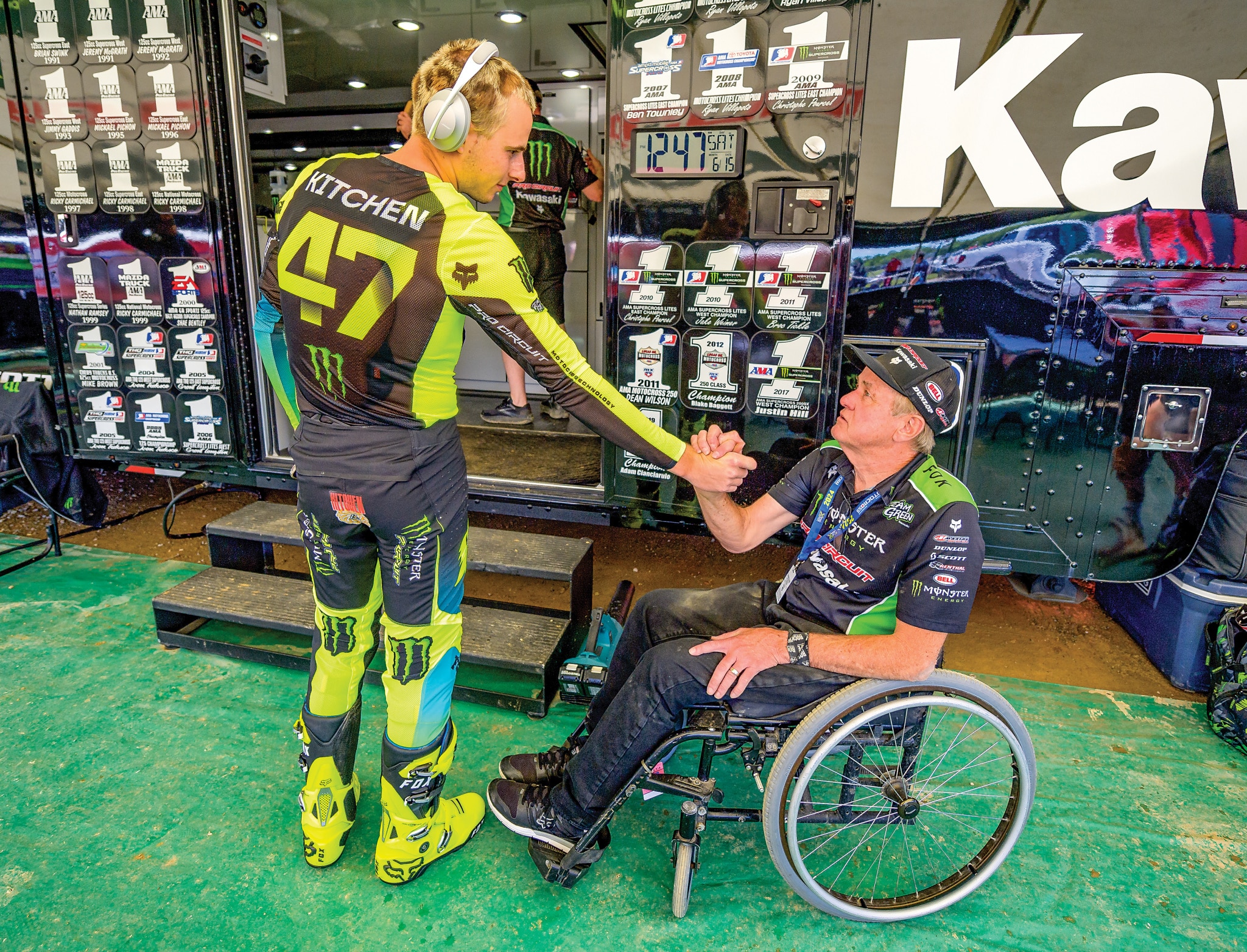 Levi Kitchen left Star Yamaha to ride for Mitch’s Pro Circuit Kawasaki team.
Levi Kitchen left Star Yamaha to ride for Mitch’s Pro Circuit Kawasaki team.
HOW DID YOU GET INVOLVED WITH THE JAPANESE BRANDS? Jody Weisel asked me, “Why don’t you make pipes for Japanese bikes?”
I was like, “Why? Nobody is going to want a pipe from Anaheim Husky for a Suzuki.” We started kicking around ideas of a name so that I could sell Husky parts to Husky dealers and other parts to other dealers.
 Pro Circuit is visible from the 91 Freeway on the way to most of the SoCal race tracks. It looks like a white Taj Mahal to motocross.
Pro Circuit is visible from the 91 Freeway on the way to most of the SoCal race tracks. It looks like a white Taj Mahal to motocross.
Jody used to come over to the shop often and doodle ideas on cardboard boxes. He said, “Why don’t you have a catalog?”
I said, “I can’t afford a catalog.”
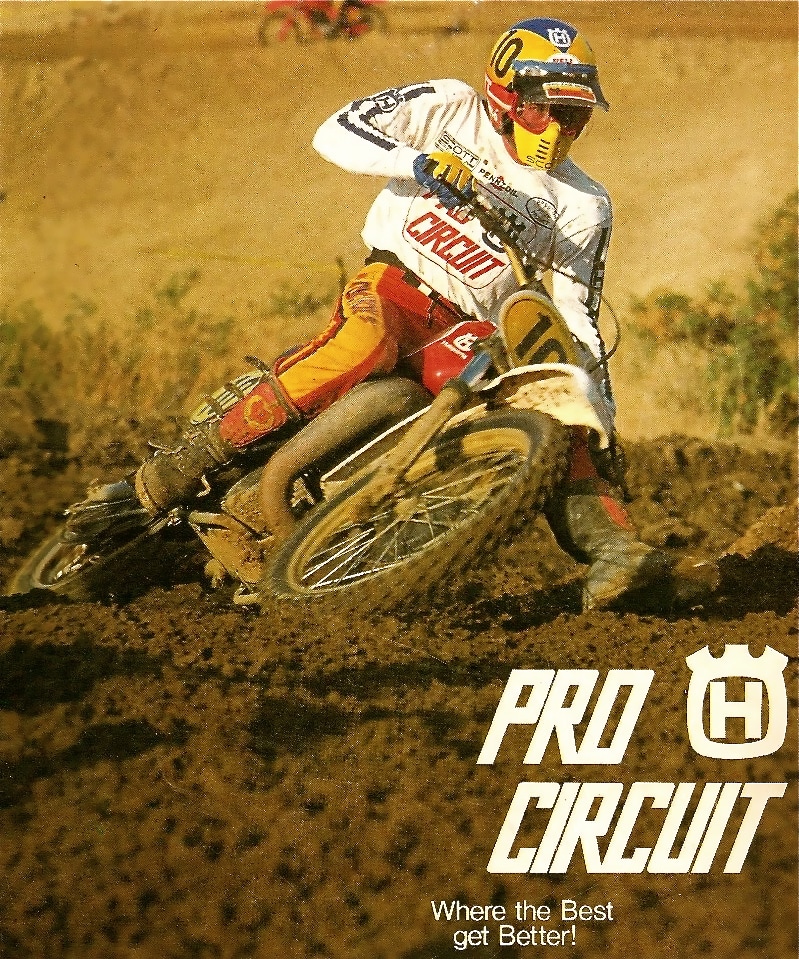 Jeff Jennings on the cover of an early Pro Circuit catalog.
Jeff Jennings on the cover of an early Pro Circuit catalog.
He said, “Just make a cheap one. Get some photos and we will put a description on them.” My first catalog was just photos. Jody helped write the copy, put a price by the pipes and made it at MXA’s office. There was no money for creating a big catalog.
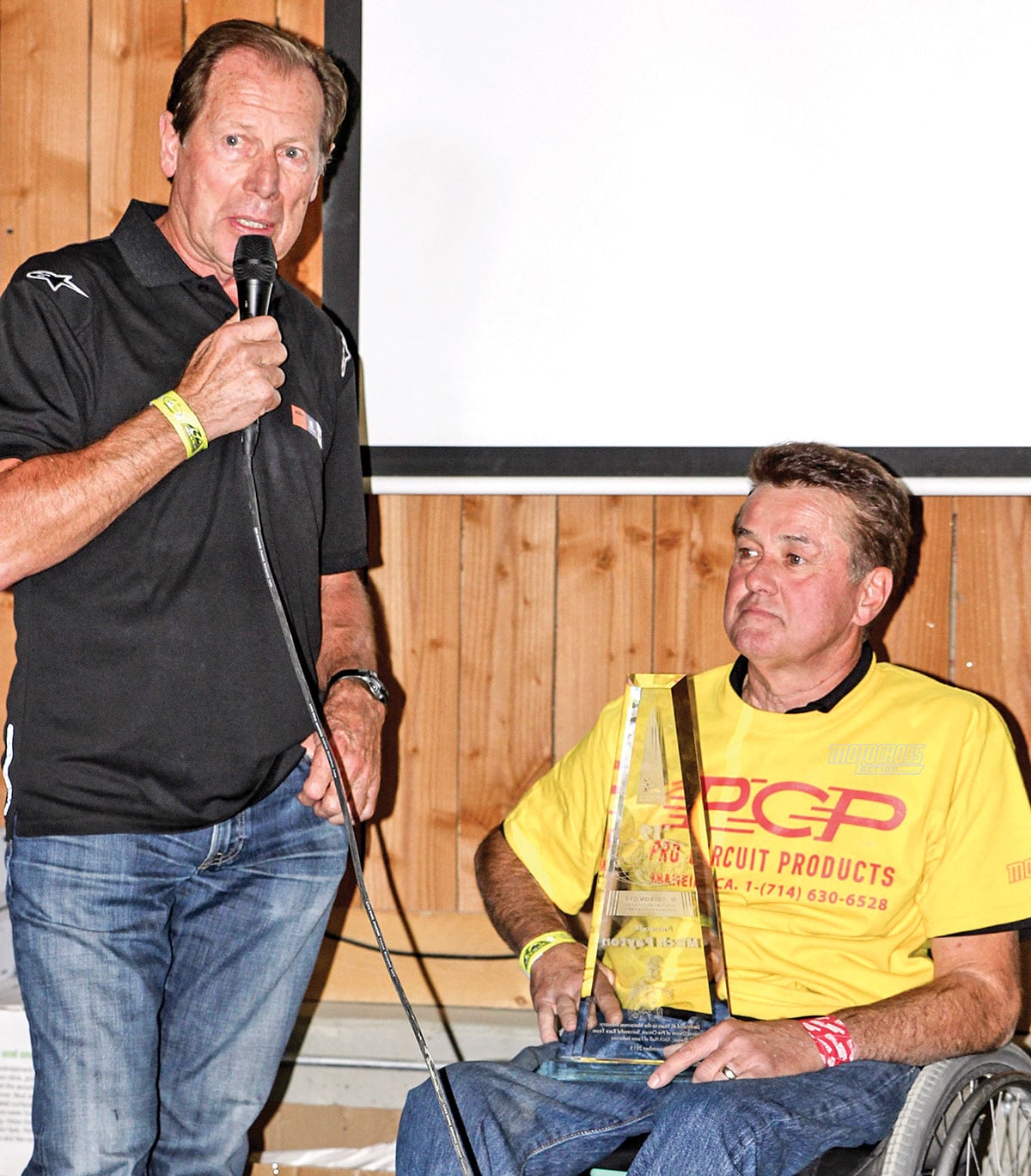 Roger DeCoster was on hand to present Mitch Payton with the 2019 Edison Dye Lifetime Achievement Award. Ever the rebel, Mitch was wearing the banned PCP T-shirt from 1979.
Roger DeCoster was on hand to present Mitch Payton with the 2019 Edison Dye Lifetime Achievement Award. Ever the rebel, Mitch was wearing the banned PCP T-shirt from 1979.
IS THAT HOW YOU CAME UP WITH PRO CIRCUIT? It was Jody, my mom and me talking. Somebody came up with Pro Circuit, as when you go pro on the circuit. We decided it should be “Pro Circuit Products.” Later, I felt it needed to be a shorter name like DG, DMC and FMF had. I came up with the idea of “PCP” and made T-shirts and stickers. But, when Jody saw the shirt, he said, “Um, are you aware of what PCP is?”
I said, “Pro Circuit Products.”
He said, “No, it is a drug, like angel dust.”
I had no idea. So that was the end of the very short PCP era. We went back to Pro Circuit.
DID YOUR AFTERMARKET PIPES TAKE OFF RIGHT AWAY? There was bit of a lull at that time, because in the late 1970s, the aftermarket stuff out there was not that good. When you talked to customers about putting an aftermarket pipe on their Suzuki or Honda, they would say no.
Jody told me that I should make pipes for the most popular bikes. I said, “They don’t need pipes. They are already fast. I prefer to make pipes for the slower bikes.”
To which he replied, “People don’t buy slow bikes. They buy the fast ones and then spend money to make them faster.”
The first pipe we did was for a Suzuki RM465 and later a Honda CR125. I didn’t know if people were going to buy them, but we sold more RM465 Suzuki pipes than we did all the Husky pipes put together. When we did a Honda CR125 pipe, it was a massive hit—bigger than the RM465 sales, because everybody at that time had a CR125.
I had a Husky shop and was spending too much time ordering Husky parts and working on Husky bikes. I had the world’s fastest Huskys, but nobody wanted to ride them. We changed our focus to building pipes.
HOW DID YOUR PIPES GET ON THE FACTORY BIKES? Paul Turner was a mechanic for a lot of factory guys at American Honda. He was leaving Honda and said, “Hey, I have a good Honda CR250 pipe. If you make it, you can sell this thing right away. I’ll build you one; have someone ride it.”
They rode it and thought it was great. We worked a deal out where I would pay him royalties per pipe.
Goat Breker went to Honda and used the pipe at the Tokyo Supercross and won. Then, in 1985, I helped Jeff Hicks on his Honda. He was getting holeshots all the time with it. He was living with Bob Hannah, and that relationship helped.
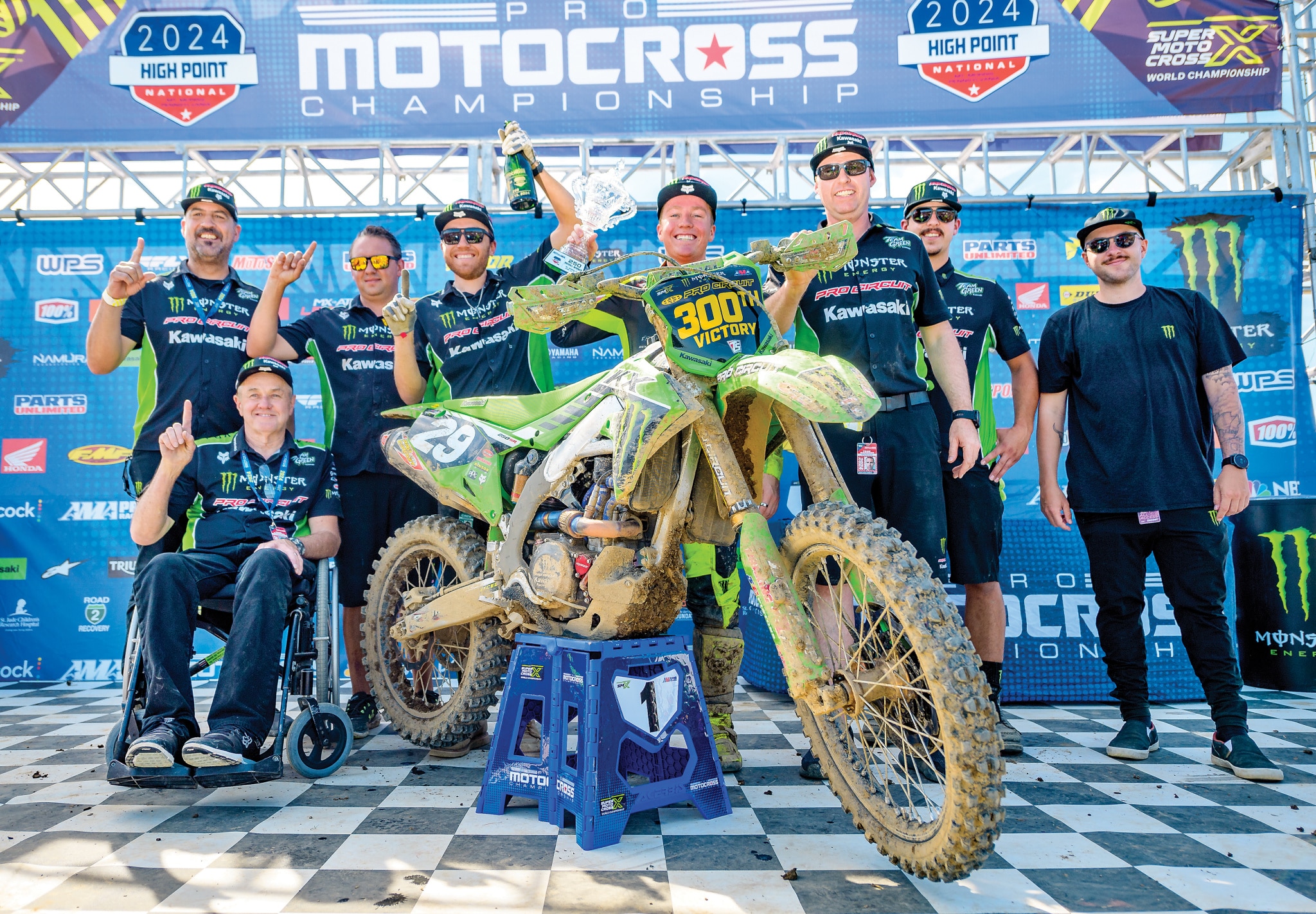 If a race team is lucky, they get to stand on the podium a couple of times. The Pro Circuit team has been up there over 300 times.
If a race team is lucky, they get to stand on the podium a couple of times. The Pro Circuit team has been up there over 300 times.
WHAT CAME NEXT? Hannah rode with a pipe and liked it. We did a Yamaha pipe for Danny Storbeck, who began getting holeshots at the Nationals. Near year’s end, Rick Johnson had one more race to do for Yamaha. They were not going to help him, so he called me and asked, “You built Storbeck’s bikes. Would you build me one?” He liked it and said, “I am going to Honda next year, and I want you to build me some stuff.”
I said, “Well, you have to get it okayed by Honda.”
Honda wanted Ricky so bad, they said, “We don’t have a problem with that.”
Then, at the end of 1985, they were getting ready for Bercy, and Roger DeCoster said, “I heard you have a good pipe. Can I ride it?” We went down by Carlsbad. Roger rode it and said, “It is actually better than our works pipe. A lot of aftermarket stuff I ride is not as good as stock. I am surprised.” That was the first time I met Roger, and we became good friends.
THEN IT EXPANDED FROM THERE? Yes, we made sure I had a pipe for Ricky. The first day he rode the bike, he said, “I like it.” Then, they had the other guys try it. David Bailey said it did not rev enough, but Ricky loved it. He ran it, while Bailey ran the HRC pipe. The next year, Kawasaki noticed and asked if we would build some pipes for them. In 1986, Yamaha asked me to do some engines. They loved them.
DID THE FACTORY TEAMS PAY TO RUN YOUR PIPES? No, we told them as long as you run the Pro Circuit tag, we will give them to you. Yamaha paid for the cylinder work, because they did not want anybody to know. It just depended on what manufacturer it was and how it worked out. We never paid anybody to run anything. We did not have the money anyway.
“300 WINS IS A HUGE NUMBER, BUT TRUTHFULLY, IF I HAD 100 WINS,THAT WOULD SEEM INSANE. IT IS A TESTAMENT TO A LOT OF HARD WORK FROM EVERYBODY AT PRO CIRCUIT, AND, OF COURSE, TO THE RIDERS WHO WON THE RACES.”
 Honda agreed that Mitch could find an outside sponsor for his 125 team. So, Mitch changed the red Honda CR125s to blue-and-white Peak Anti-Freeze Hondas. It turned out to be a great markting move for Honda, Pro Circuit and Peak.
Honda agreed that Mitch could find an outside sponsor for his 125 team. So, Mitch changed the red Honda CR125s to blue-and-white Peak Anti-Freeze Hondas. It turned out to be a great markting move for Honda, Pro Circuit and Peak.
HOW DID IT COME ABOUT THAT YOU BECAME HONDA’S 125 TEAM? Once I sold the Husky dealership, we became Honda guys. Everyone rode Hondas back then. In the Nationals, we helped some of the top privateers, and Honda ran our pipes when they would go to the Bercy Supercross and the away races. We started helping them on their 500s in 1988. Then, we helped Mike Kiedrowski, who was a Honda support guy.
In 1989, Honda had George Holland as a factory HRC guy and Guy Cooper as another factory support guy. In the 125 Supercross, they had Larry Ward on one coast and Mike Kiedrowski on the other. I wound up doing Kiedrowski’s bike. George was on the HRC pipe. Guy Cooper ran FMF. We went to Gainesville, the first outdoor of the year, and Kiedrowski went 1-1 in the 125 class. Jean Michele Bayle, who we were sponsoring, won the 250 class with a 1-1.
THEY WEREN’T FACTORY HONDA BIKES? They were production bikes with engine work and suspension. Later, Dave Arnold wanted to get everyone together on the same setup. They went to this test at Carlsbad. I was not allowed to go. At that test, all the riders decided that Mike Kiedrowski’s bike ran the best, so Dave called me and said, “We are going to run your cylinder, head and pipes for the year. Everybody is going to run them.”
We then talked about taking over the whole team. I said, “We need to find a sponsor.” I could not afford a full-time Supercross and National team by myself. We found a way to do it with Peak antifreeze and Splitfire spark plugs.
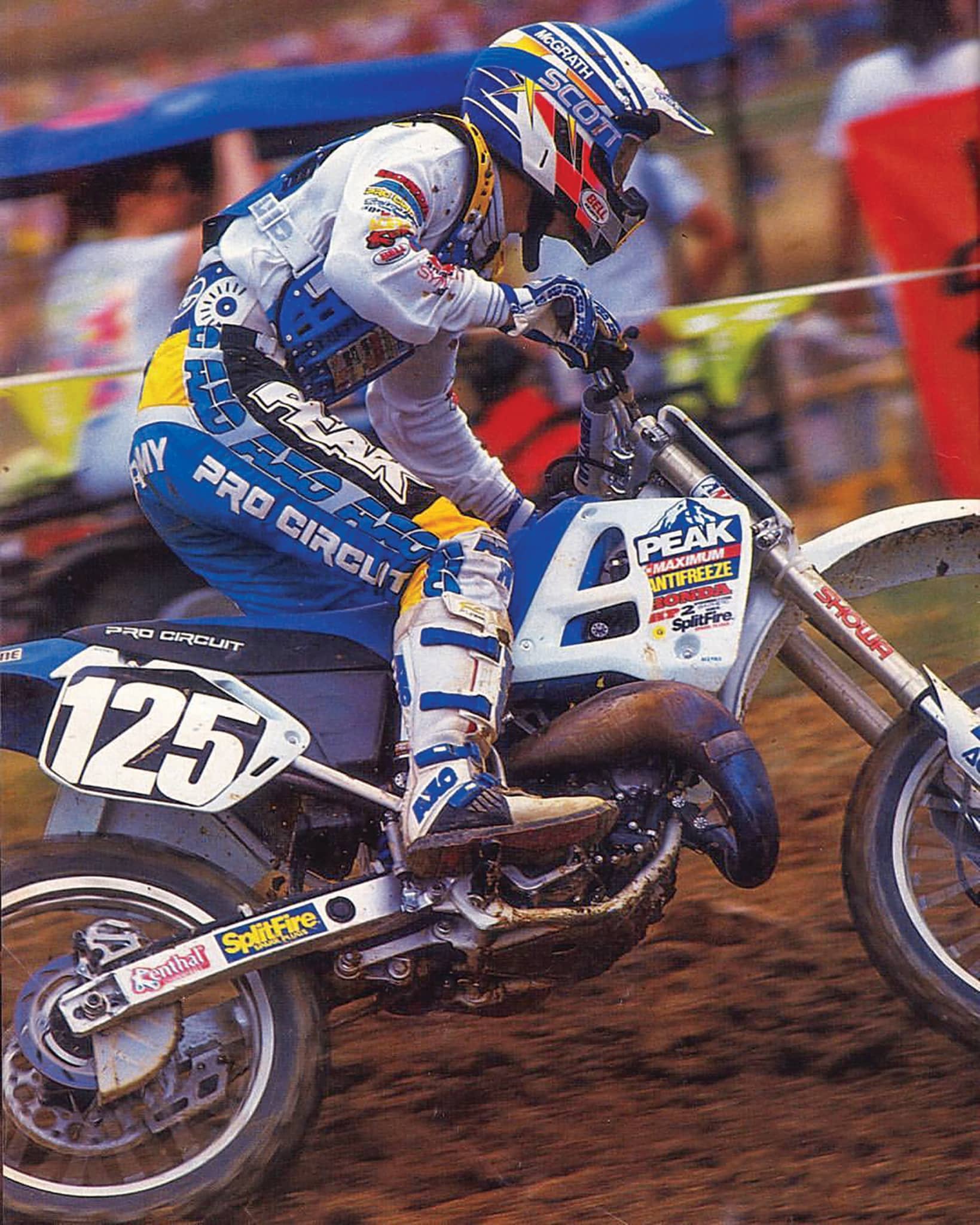 Jeremy McGrath on his Peak CR125 Honda.
Jeremy McGrath on his Peak CR125 Honda.
WASN’T THAT A VERY LAST-MINUTE DEAL? To be honest, it was very late when they put it together. Jeremy McGrath had already signed his Honda contract, and I think Brian Swink had already signed his contract. So, they thought they were going to be in-house Honda factory guys.
YOU TRULY CHANGED THE LOOK OF MOTOCROSS WITH TEAM PEAK. If I was going to do it, I wanted it to look better. We wanted everybody to dress the same, so we looked like a team. The mechanics had expensive embroidered crew shirts. Troy painted all the helmets, and the box vans looked the same. The Honda CR125s were red, and we changed them to blue and white. It was outstanding how it looked. This was what the sport needed to go to another level. Jim Hale at AXO really believed in it, and Jody was behind it.
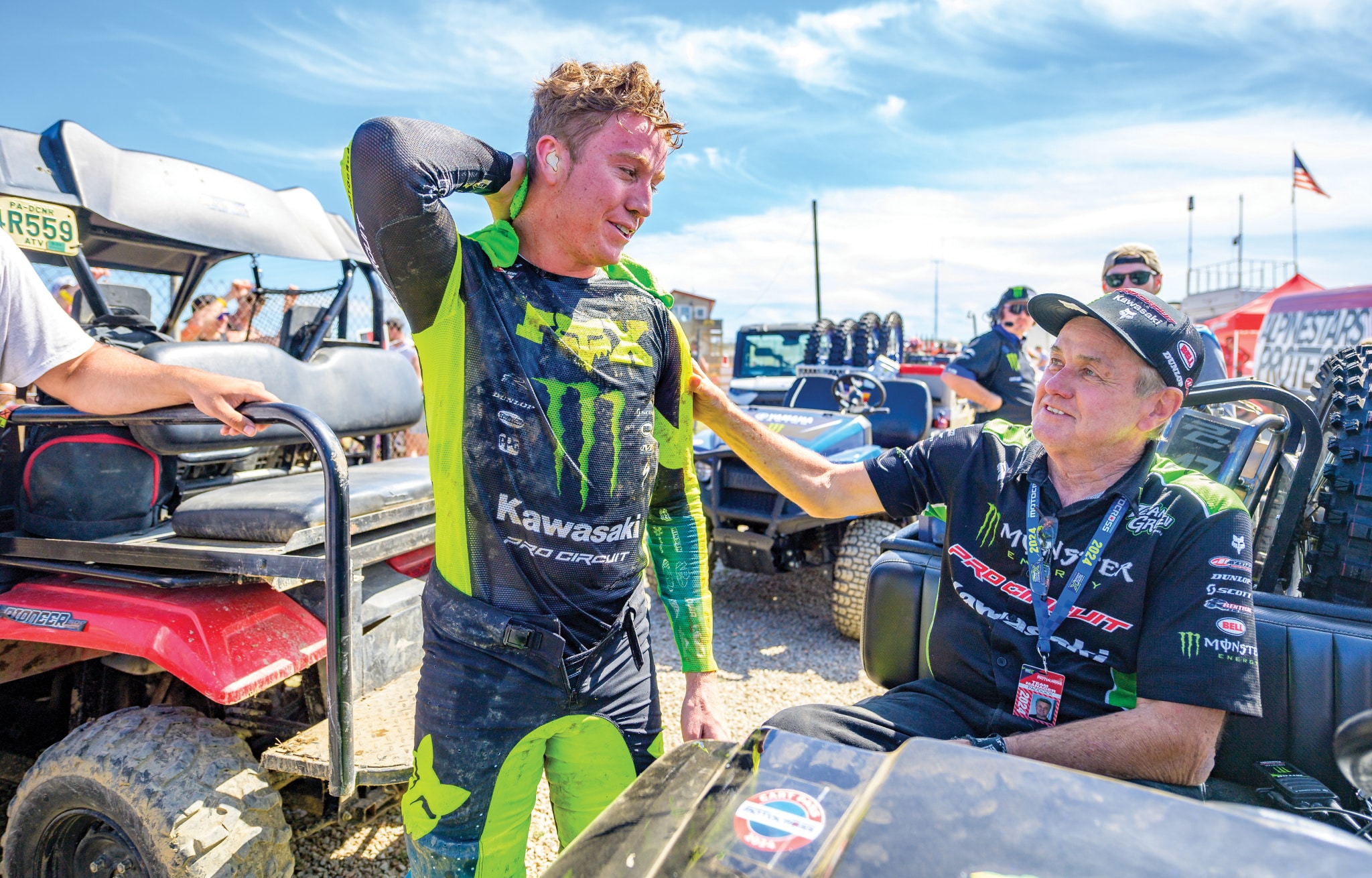 Mitch with Ty Masterpool: “I get a kick out of winning. I love seeing a guy win his first race, and I like seeing a guy win his first championship.”
Mitch with Ty Masterpool: “I get a kick out of winning. I love seeing a guy win his first race, and I like seeing a guy win his first championship.”
WAS ANYONE NEGATIVE? We did get flak from some Honda dealers because Honda had just come out with the “Ride Red” marketing plan and our bikes were blue and white. The dealers could not get their heads around it, but I said, “It is an outside sponsor. Those are their colors. You can sell a plastic kit for it. Overall, everybody finally embraced it.
TEAM PEAK IS NOW ICONIC. WHY DID IT ONLY LAST TWO YEARS? I don’t know that I ever got the truth. It could not have been results-driven, because we did really well. We handed off McGrath to them, and look at the career he had there. They basically said, “We wanted to see if you could do it without us putting any money into it.” It was an experiment. Very strange.
WAS THE MOVE TO KAWASAKI EASY? It would have been easy had I known earlier, but I thought I was going to stay with Honda—until they told me I wasn’t. Honda left me in the dark. I was probably the last person to know. Mark Johnson at Team Green called me and said, “Hey, I don’t have much, but if you want to do it, I would love to have your team on Kawasakis. I can promise you that next year I will get more budget for it. We need to keep this thing going because we need somebody in the 125 class.”
I did not have any other offers, so I said, “I guess I can try it for a year and see if we can make it work.” It was literally bikes, parts and not a lot else. We were already out of parts in November, and I had to write them a check. I made sure we paid our bills as we went, and he respected that. He went to bat for me to get more help.
YOU’VE BEEN WITH KAWASAKI EVER SINCE. We had a couple of ups and downs as we went along for sure, but I liked seeing all those Kawasaki guys happy. I believe Ricky Carmichael did that, along with Ryan Villopoto. A lot of the good guys are like that. If they have won a lot, they want to win for you. I am that way also. I want it for them. I do get a kick out of winning. I love seeing a guy win his first race, and I like seeing a guy win his first championship. I like seeing people succeed.
WITH RIDERS LIKE BAYLE, PICHON, TOWNLEY, POURCEL & RATTRAY, YOU SEEMED TO KEEP YOUR EYE ON EUROPE. We used to go to Bercy every year and see those guys. I remember the first time I met Jean-Michel Bayle. We had been helping him on a private Honda. He was doing well and wanted to come to the U.S. We helped him in 1989, and then he went straight to the factory Honda. We started watching these dudes ride, and I knew that we needed to pay attention to them. If a racer has the talent to race the GPs, he should be able to ride Supercross. It is a different thing, but they can learn.
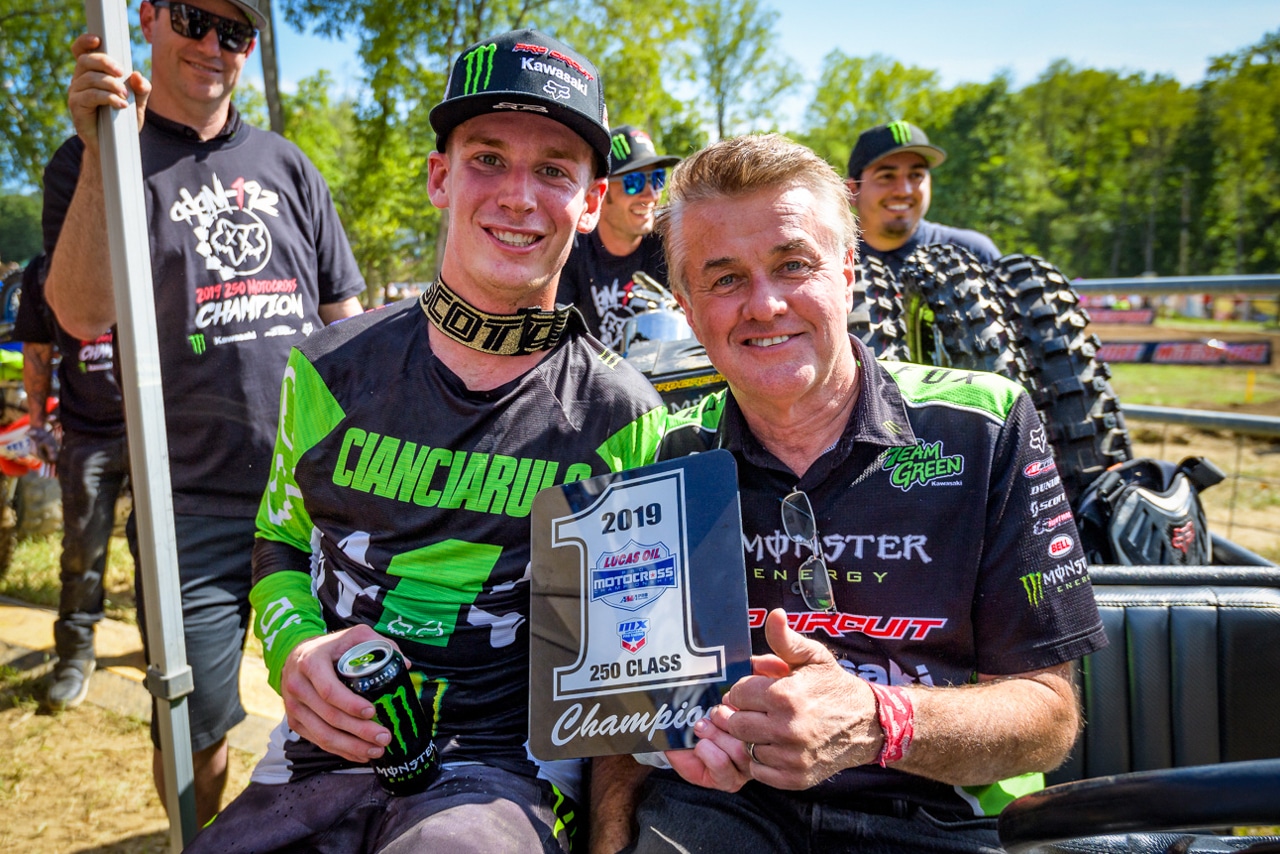 Mitch may have been tough on his riders, but he always stood by them, proved by his long-term support of Adam Cianciarulo. It paid off in 2019.
Mitch may have been tough on his riders, but he always stood by them, proved by his long-term support of Adam Cianciarulo. It paid off in 2019.
I’VE ALWAYS HEARD THAT YOU CAN BE VERY DEMANDING. IS THAT TRUE? I was harder on my riders in the early days. Now, I try to do it without yelling or freaking out. I just tell them the truth: “Here is what you need to do. You must pull yourself together.” That is all there is to it. Other people may not agree with me, but in the old days, I feel that the kids were tougher. Now, if you are too hard on them, you hurt their feelings, so you must be careful. It is just a different era. It is not just our team, it is everybody.
HAVE YOU HAD ISSUES WITH RIDERS’ PARENTS? There are parents who are super mellow and parents who are hard to deal with, but parents have seen their kids ride more laps than I ever have. Their insight can be valuable. I don’t think modern kids are mature enough when they first turn pro to handle everything on their own. From the age of 11, they hop in the van, and Dad drives them to the races, unloads the bike, puts it on the bike stand, oils the chain, puts gas in it, takes them to the line, and then takes the bike home and works on it.
WHAT ABOUT DEALING WITH THE RIDERS’ AGENTS? When you are young, I don’t think a rider needs an agent, because the good kids, everybody already knows who they are and will make offers accordingly.
There are some agents today, like Lucas Mirtl, who represent a lot of riders. I have had my ups and downs with him, but he is a pretty good guy. I don’t mind that he represents some of our riders. I just tell him to treat me fairly. If you treat me fairly, we can get along great. It does take some pressure off the kids to not have to talk about things they don’t really understand, and a good agent can protect them in the future. The more money involved, the more important an agent is.
YOU RECENTLY ACHIEVED YOUR 300TH TEAM WIN. HAVE YOU TAKEN IT ALL IN? That is a huge number, but truthfully, if I had 100 wins, that would seem insane. To get 300 wins is testament to a lot of hard work from everybody at Pro Circuit, and, of course, to the riders who won the races. I realize that it is a big number.
HOW ABOUT A FINAL COMMENT? Old guys used to say, “If you are not the best cowboy, you better have the best horse money can buy.” That is similar in our sport, but the best cowboy can still make up for it.


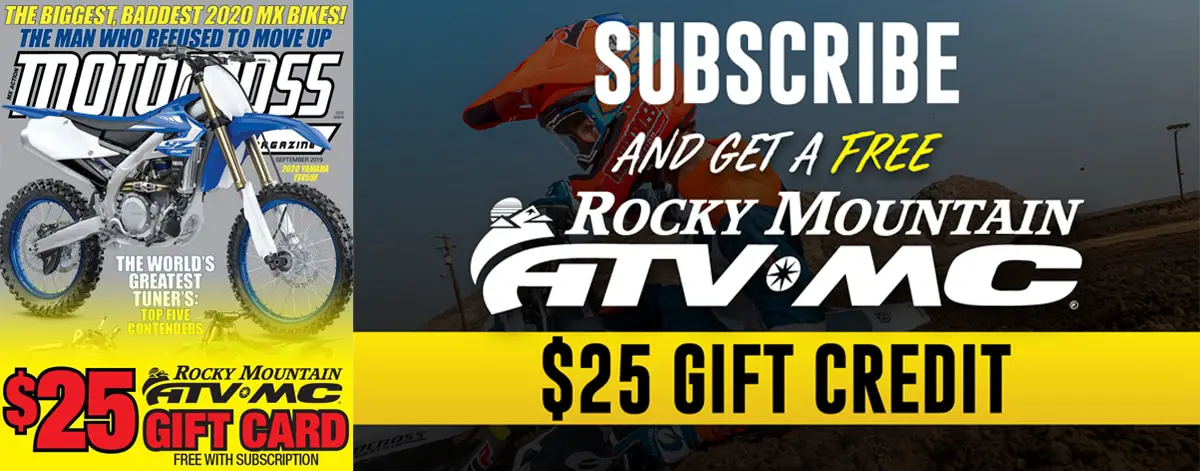



Comments are closed.